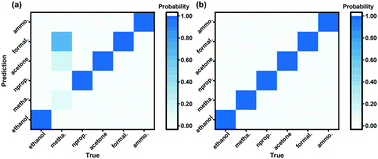A simple microwave-assisted method was applied to synthesize zinc oxide (ZnO) with controllable hierarchical structures. In a surfactant-free solvent system, the hierarchical structure of the ZnO precursor can be regulated by the concentration of urea at normal temperature and pressure. Upon annealing, ZnO with different morphologies shows its unique response towards six kinds of gases. The response data were clustered and analyzed by principal component analysis (PCA) to provide a basis for feature extraction. The classification to six kinds of gases was conducted through a model based on linear ridge classification (LRC), support vector machine (SVM). The prediction of ethanol concentration was achieved using backpropagation (BP) neural network and extreme learning machine (ELM). The results indicate that the six confusing gases can be distinguished clearly using SVM with an accuracy more than 0.99. Furthermore, the prediction of ethanol concentration shows a prominent performance (R2 > 0.98) by the ELM-based regressor, despite the nearly saturated response of the sensor array. This study explores the possibility of pattern recognition analysis based on machine learning to further improve the detection performance of the gas sensor array with different response characteristics regulated by the morphology.

